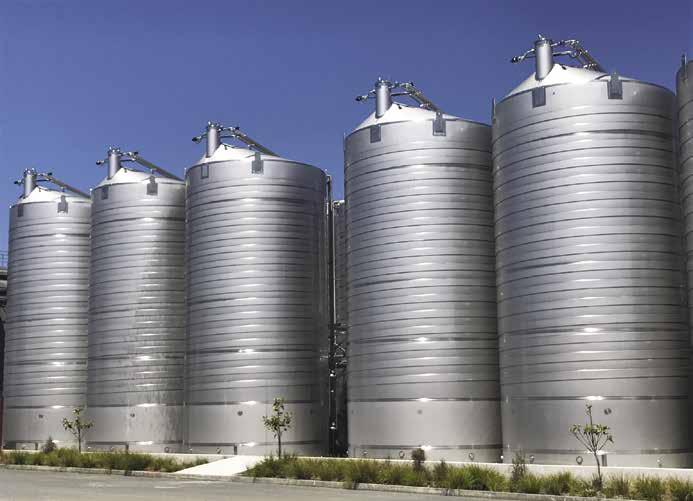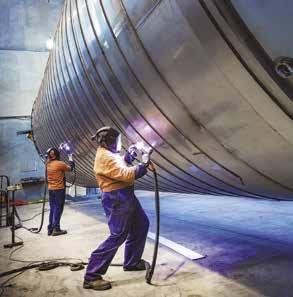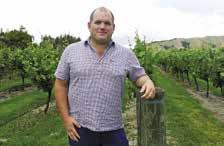
13 minute read
Earthquake Recovery
Smart Tanks
Earthquake damaged winery rebuilt safer and smarter
Advertisement
SOPHIE PREECE
WHEN PERNOD Ricard Winemakers’ head office asked about the potential for injuries, in the November 2016 Kaikoura earthquake, the answer was clear. “They said, ‘if it had been during the day, would there have been injured employees?’ And we said ‘quite likely’,” says Pernod Ricard group winemaker Jamie Marfell.
Two years on, the company’s vast Riverlands winery has been transformed, with catwalks abolished, telemetric analysis installed, thicker stainless steel, deeper concrete and stouter tanks with sacrificial fuses. “These are all smart tanks,” says Jamie. “We are working towards a ground level winery.”
Instead of vintage staff poised above tanks to take measurements, they now have pressure transducers that measure volume and temperatures, as well as offering automated systems for adding nitrogen. “It’s a new way of working for us. It was a chance to rebuild the winery in a safer, more innovative way.”
As well as being safer, the winery’s improved design and telemetry offers more speed and efficiency, helping ensure juice is in ferment as soon as possible after harvest. “It’s still a work in progress, but we are focused on a winery of the future,” he says.
Marlborough’s wine industry was hit hard by the magnitude 7.8 Kaikoura earthquake, which struck just after midnight on November 14, 2016. The timing meant no winery staff in the region were injured, but the earthquake resulted in damage to approximately 20% of Marlborough’s tanks.
Following the 2013 Seddon earthquake, Pernod Ricard’s damaged tanks had been repaired using a safer design, with bottoms cut off and seismic bolts added. These tanks withstood the most recent quake, but other damaged tanks needed to be replaced. T&D Construction built a workshop on the Riverlands site, and by vintage Crown Sheetmetal had built the winery half a million litres worth of “beautiful tanks”, some of which were finished just days before use, says Jamie. “Everything else has been built subsequent to that.”
The gleaming visible parts of the operation - including new flow plates and elevated hoses that rotate on a wheel for easy use - tell just a fraction of the story, with up to 750mm of concrete and reinforcing beneath the tanks, and cutting-edge technology within them. The tanks’ stainless steel is far thicker and the seismic anchors are far better, says Jamie.
“We are still working on the finer details and developing the level of precision we want in the winery, so that we have information on volumes and analysis at our fingertips. We are looking at the next layer of technology.”
Insurance update
Insurance industry shaken by hurricanes, fires and earthquakes
NEW ZEALAND’S insurance landscape was transformed by the 2016 Kaikoura earthquake, says ICIB senior broker Daniel Szegota. “This was the catalyst for change with a hardening market already on the horizon. Local insurers set about reviewing their portfolios to return to profitability, reviewing their exposures and imposing significant premium increases - with mixed success - to high risk business and industries.” He says local earthquake pricing has now stabilised with minimal increases, “however the Natural Disaster Site Excess structure and percentage basis are here to stay for the foreseeable future”. In general, there is still little appetite for high hazard risks or growth, Dan says. “High natural catastrophe zones remain under scrutiny with no insurer willing to materially increase their exposure in those regions.”
The increase in frequency and severity of local weather events continues to challenge Tank rebuild following Kaikoura earthquake. Photo Jim the industry, while the Tannock fire risk around expanded polystyrene (EPS) is also concerning insurers, following large fire losses globally, says Dan. “EPS features throughout the wine industry to varying extents. The insurance market in this sector is contracting and there is a finite amount of capacity amongst local and global insurers for risks where high levels of EPS are present. This lack of capacity, and therefore competition, is resulting in significant premium increases for these risks”.
Dan says the insurance market will continue to drive for nominal (non earthquake) premium increases throughout the remainder of 2018, citing local losses in 2016 and the high cost of “global catastrophes” in 2017. “Insurers that have remediated their portfolios may start to compete again on quality business.” However, he says it is likely, based on previous cycles, that the upward premium curve will not be sustained over a long period “with insured losses over the next 6 months determining the actual period of premium increases and/or underwriting controls”.

Global matters - Dan Szegota looks at the bigger picture for insurers
After a number of years of profitable underwriting results and benign claims that encouraged new capital into the market and drove competition, market conditions took a major hit in 2017. Posting an estimated US$135 billion of insured losses, much of it coming from Atlantic hurricanes, 2017 rivals 2005 and 2011 as the largest insurance loss year on record. As a result, it was clear that the insurance market would end premium rate reductions, in the short term at least. There is clear upward movement in pricing, however these increases have generally been restricted for all but the most difficult risks. Insurers and their reinsurers are still focused on areas with high natural catastrophe risk, and, naturally, this includes New Zealand.
Fire & Emergency Levy Update
Fire service levies collected through contracts of fire insurance was subject to significant change from 1 July 2017. The Government’s introduction of the Fire and Emergency Services Act 2017 replaced the Fire Service Commission with a new organisation, Fire and Emergency New Zealand (FENZ), bringing together 40 urban and rural fire services. The increased funding requirements of the new entity will continue to be met through the collection of insurance levies. This initially resulted in a 40% increase in the levy charged on material damage policies covering the peril of fire. Complex changes to the way the levy is calculated were proposed to commence from January 1 next year, having already been delayed from an initial date of July this year. Significant consultation between the government and insurance industry representatives over challenges in interpretation and implementation of the changes proposed by the legislation has resulted in a revocation order. This has further delayed the implementation date to July 1 2019.
Daniel Szegota is a senior broker at ICIB Ltd
Trucking on
Transport logistics integral to wine industry post-quake review
TRANSPORT LOGISTICS are an “essential component” to strengthening the resilience of the wine industry, say researchers behind a three-year study funded by the Ministry for Primary Industries’ Earthquake Relief Fund. The outcomes of the study, to be released in 2020, include identifying key vulnerabilities faced by the industry and better understanding risks and opportunities to build resilience along the entire value chain, from vineyard and winery operations to the market, both domestic and international, offshore and tourists.
Lead researchers Nick CradockHenry of Landcare Research, and Joanna Fountain of Lincoln University, say the input of transport company QuayConnect highlighted the significance of transport issues. “We went into the study thinking, for example, that there will be the need for structural fixes, such as creating more robust storage facilities, redesigning tanks, having better piping and building infrastructure within the winery to withstand shaking,” says Nick. “Yes, those things are still very important but it’s clear after hearing from the QuayConnect members of our advisory group and within the workshops that transport issues are really going to be one of the top areas to address.”
Following the November 2016 Kaikoura earthquake, QuayConnect ensured bulk wine reached Port Nelson and was shipped to its international or domestic markets, while supplies like glass bottles made it back to Marlborough. Joanna says QuayConnect’s success in maintaining and increasing freight operations immediately after the event “has been really instructive to how wineries can plan ahead and change their behaviours to be better prepared”.
Following an initial scoping phase, the study is now working with industry partners, wineries, and grape growers documenting and analysing the impact of the earthquake and looking at the wine industry’s responses in the aftermath. Joanna says individual companies can start to become more self-reliant and prepare for a major event. “Businesses have to think, if we’re down to one road, what do we need to have happen for our supply chain to keep functioning? Companies are saying they need to work on strategies themselves to address these risks because systemic change won’t happen quickly.” Nick says the project team will provide recommendations by mid-2020, to help individual companies, industry groups, and local and central government prepare for the unexpected.

Two new seaweed options
Stim Concentrate Liquid and FoliaStim Mn, Zn Liquid are two great new seaweed options available to you through Horticentre. They are both based on Ascophyllum nodosum and designed to: Increase root growth Increase stress resistance Improve plant vigour Be soft on leaf tissue Be easy to handle and apply


Grape Marc
Drying grape marc a good solution, says new company
MACHINES THAT remove the moisture from grape marc are key to a new initiative for vintage 2019. Pacific Rim Environmental Services is establishing a facility in Marlborough to dry out grape marc within 48 hours of delivery, so that it does not create the environmental issues of leachate and odour. “We want to offer growers a choice in how they deal with grape marc,” says director Chris Bowhill. “What were once waste materials to be discarded, can be made into useful products, reducing carbon footprints and saving resources.”
Marlborough produces around 60,000 tonnes of grape marc a year, and the winery by-product can be 75% water, creating headaches around its safe storage. The company’s plan is to reduce that water content, ideally within 24 hours, making it safe to store. Then at a later date it can be returned to the vineyard, or further processed, says Chris.
The service - to be run with a gate fee, with no long-term contracts - will be available “proof of concept for commercialisation” this vintage, with plans to expand as a full scale service, which will produce dried marc pellets, he says. The company has partnered with a winery for the proof of concept and contracted space in an industrial estate.
Pacific Rim is one of two new services being offered to growers, with Remarc planning to produce biofertiliser from marc in the future, using a fully contained anaerobic digester. Remarc is a joint initiative between renewable energy company, Energy3 Limited, and Marlborough wine company Indevin, and will offer the biofertiliser to grape growers at a lower cost than synthetic fertiliser.
The new grape marc solutions come in the wake of several prosecutions relating to grape marc storage in 2016, and the announcement earlier this year that GrowCo, a company with consent to process 40,000 tonnes of marc, would not operate in vintage 2019.
Wine Marlborough general manager Marcus Pickens welcomes the new initiative. “The push for a solution to the grape marc processing challenge has had a good response from those within industry and players outside it. We’ve definitely made progress and the fact that there are a few different approaches being explored is exciting to see.”

Chris Bowhill
Spreading Grape Marc to Vineyard
At the recent Wine Marlborough grape marc meeting, there was some confusion over the rules and regulations around spreading grape marc direct to land. To read some case studies of wineries using this procedure, check out the August 2018 Winepress, which is available on the news page of www.wine-marlborough.co.nz.
The Marlborough District Council guidelines for spreading grape marc to land stipulate: - No application to occur within 50m of any bores - No application within 20m of any waterway, wetland or drainage channel - No application within 10m of a dwelling on any land in different ownership - The total cumulative nitrogen loading to the area cannot exceed 20kg of nitrogen per hectare per year
Powering On
Marlborough Lines reduces risk of ripple control
MARLBOROUGH GRAPE growers are unlikely to face irrigation shutdowns this summer, after heavy November rainfall offered a reprieve. Marlborough Lines had informed irrigators that it might instigate ripple control between 7.30am and 12noon on a number of days to deal with national grid transmission peaks over summer, and particularly this month.
But managing director Ken Forrest says rainfall has greatly reduced power demand further south, reducing the need for load management in Marlborough. That’s a welcome relief, says grower Guy Lissaman, who received notification from Marlborough Lines in mid-November, and spoke to more than a dozen irrigators equally concerned by the news.
Timely communication would have made a big difference, he says. “Even if they had flagged, ‘we are not 100% sure yet, but it looks like this might be a reality from summer 2018/2019’. We could have started saying, ‘OK we need to get our ducks in a row and get organised’.” He says the change in circumstances is a shortterm reprieve, but the risk of future ripple control is still of concern.
Ken says irrigators on cheaper ripple control rates have always faced the possibility of interrupted supply. Over the past several years they have had the benefit of full time supply for a lower ripple control rate, he says. “They have paid for something less and got something better.” The line company has signalled to irrigators that there is an alternative plan they can go on, but it is more expensive.
He says increased levels of dairy and cropping further south are putting pressure on transmission over summer months, with consequences for Marlborough. Last year 75 of the 100 peak-half hours were in the summer. Marlborough Lines is part of an upper South Island lines company collective that works together to manage loadings on the transmission system.
Guy says there are a range of complex issues growers need to address if ripple control is instigated in the future, including aligning frequencies on coordinated pumps,
so that the loss of power on one frequency does not take out the other. He says it is of particular concern to large community schemes with multiple pumping systems and numerous offtakes. Such schemes will need a communication strategy, ensuring that if the pumps go down all users are advised to turn their own pumps off, so they don’t drain the mainline. “If you do drain the mainline on a large scheme it can take over half a day to recharge.”
Ripple control is likely to coincide with peak irrigation demand, when some irrigators would otherwise be pumping 24 hours a day, seven days a week, says Guy. Given the nature of water consents, “the reality is if you lose a portion of your day’s pumping, you generally cannot catch up”, he says. “That is lost to the system.”
He has spoken to one person who recently invested in a new pumping system but now wonders whether he should have chosen an alternative to mains power, says Guy. “We get thrown curve balls and this is certainly one. I think the key thing going forward is if we can have advanced warning of a shutdown then we can make sure our pumps are turned off. And also having notification when the power is actually re-established, so that we minimise the down time.”
Ken says although it is unlikely to be required this summer, Marlborough Lines has established a text alert system, which will inform growers when the power has switched off, and on again. More advanced notice is not an option, because the transmission demand is dependent on the “vagaries” of weather and electricity demand in the network from Ashburton north. He says the demand management does not indicate a lack of infrastructure development. Managed effectively, the system is sufficient, and users who want 24-hour supply can have it, at a higher price, he says. “There is no issue in terms of capacity. It’s just a question of people paying for it.”


